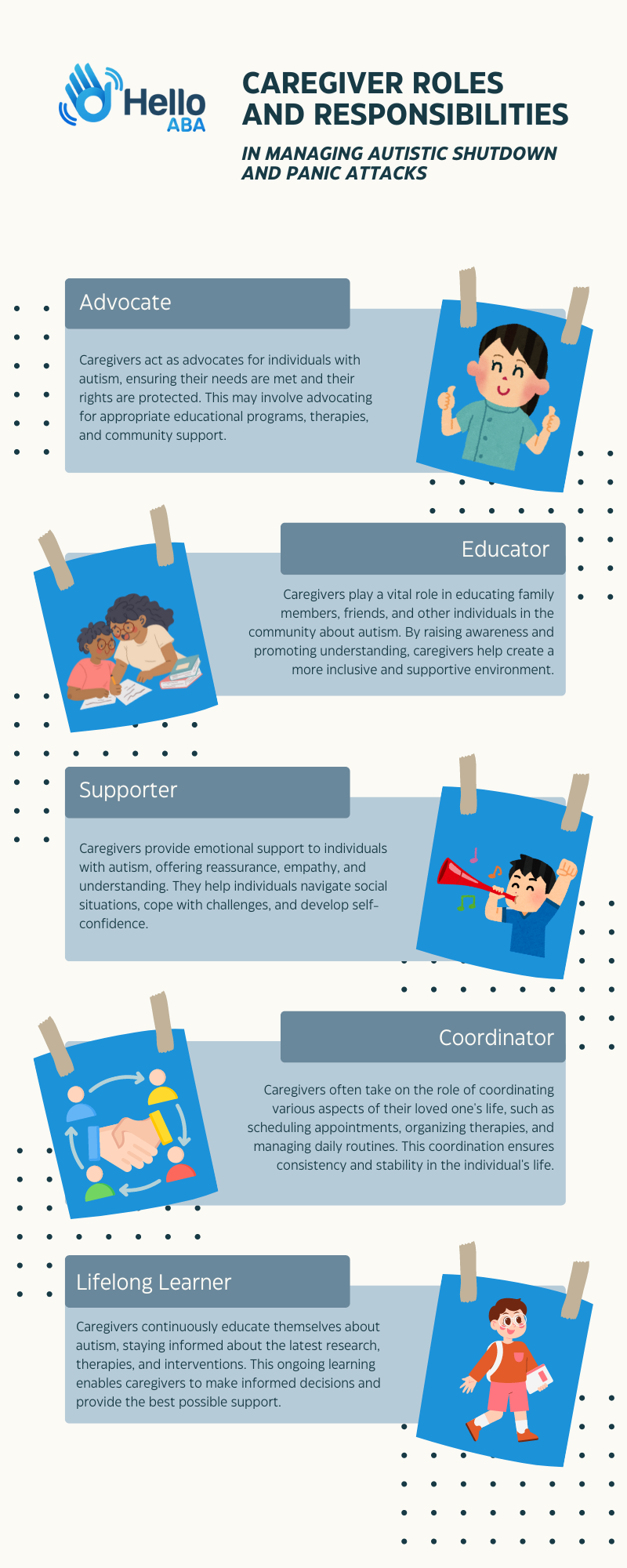Imagine feeling overwhelmed and experiencing a sudden emotional and physical crash. It’s a common experience for many individuals on the autism spectrum, often referred to as an autistic shutdown. However, it can be easy to confuse this condition with a panic attack, especially for those who are unfamiliar with both conditions.

Autism Shutdowns Explained
Autism shutdowns are involuntary reactions to overwhelming stress experienced by individuals on the autism spectrum. During a shutdown, the person’s system enters survival mode as a way to cope with the intense sensory and emotional overload they are experiencing. It is crucial to note that shutdowns are not a form of misbehavior or intentional avoidance.
During a shutdown, the individual may withdraw and appear unresponsive. They may become nonverbal, have difficulty with motor skills, and experience a significant decrease in their ability to communicate. The individual may also exhibit signs of being overwhelmed, such as covering their ears, rocking back and forth, or seeking a quiet and safe space.
Characteristics of Shutdowns
Shutdowns in individuals with autism can be triggered by various factors, including sensory overload, hypersensitivity, unexpected events, sudden changes in routine, and difficulties in social situations. The specific triggers can vary from person to person, and it is important to identify and understand the unique triggers for each individual.
During a shutdown, it is crucial to provide patience, support, and understanding. It is important to remember that the individual is not in control of their reaction and that they are experiencing extreme stress. Offering breaks and respecting the individual’s need for a calm and safe environment can help them regain their sense of stability.
Triggers for Shutdowns
Shutdowns in individuals with autism can be triggered by various factors. Understanding these triggers is essential to help prevent or minimize the occurrence of shutdowns. Some common triggers include:
Triggers |
Sensory overload |
Hypersensitivity |
Unexpected events |
Sudden changes in routine |
Difficulties in social situations |
Support Strategies for Shutdowns
When a shutdown occurs, providing the right support is crucial. Here are some strategies that can help during a shutdown:
- Patience and Understanding: Recognize that a shutdown is an involuntary reaction to stress and refrain from judgment or punishment. Show empathy, understanding, and patience towards the individual experiencing the shutdown.
- Identify Triggers: If possible, identify the trigger(s) that led to the shutdown. Understanding the specific triggers can aid in developing strategies to prevent similar situations in the future.
- Offer Breaks: Provide the individual with a calm and quiet space where they can take a break and regulate their emotions. This safe space allows them to decompress and regain control.
- Respect Individual Needs: Respect the individual’s need for personal space and time during a shutdown. Avoid forcing interaction or demanding immediate responses. Instead, offer support and reassurance when they are ready.
- Visual Supports: Utilize visual supports, such as visual schedules or social stories, to help individuals with autism understand and navigate their environment. These visual aids can provide a sense of predictability and structure, reducing anxiety and potential triggers.
- Communication: Use clear, concise, and calm communication during a shutdown. Speak softly and avoid overwhelming the individual with unnecessary information or demands.
Exploring Panic Attacks in Autism
Silent panic attacks are a specific type of panic attack experienced by individuals with ASD. These panic attacks manifest as internalized distress and shutdown behaviors, such as withdrawal, avoidance, or repetitive movements. Unlike typical panic attacks, silent panic attacks in individuals with ASD may not exhibit outward signs of panic.
Sensory overload and overstimulation can serve as primary triggers for silent panic attacks in individuals with ASD. They overload the nervous system, heightening anxiety levels and leading to a silent panic attack. These attacks can be difficult to detect, as the individual may retreat inward rather than outwardly expressing their distress.
Causes of Panic Attacks
Several factors contribute to the occurrence of panic attacks in individuals with ASD. They often struggle with the complexities of social interaction and may experience fear of misunderstanding or rejection. These anxieties can lead to heightened stress levels, ultimately resulting in a panic attack.
Routine disruptions and change-related anxiety are also common precursors to panic attacks in individuals with ASD. The need for predictability is a characteristic feature of autism, and when faced with unexpected changes, individuals may experience heightened anxiety levels, triggering a panic attack.
Panic Attack Triggers
Understanding the triggers for panic attacks and implementing effective intervention techniques can help manage and alleviate the impact of these episodes. Below are various factors that may contribute to panic attacks in individuals with autism:
- Sensory Overload: Overwhelming sensory stimuli, such as loud noises, bright lights, or crowded spaces, can contribute to panic attacks. Individuals with ASD may have heightened sensitivities to certain sensory inputs, making them more susceptible to these triggers.
- Changes in Routine: Disruptions to familiar routines can cause significant anxiety and stress, leading to panic attacks. Individuals with autism often rely on structure and predictability, so unexpected changes can be particularly challenging for them.
- Unexpected Situations: Novel or unfamiliar situations can be overwhelming for individuals with ASD, potentially leading to panic attacks. Lack of familiarity and uncertainty about what to expect can trigger heightened anxiety levels.
- Social Stressors: Difficulties with social interactions and communication can contribute to panic attacks. The fear of misunderstanding, rejection, or being overwhelmed by social demands can lead to intense feelings of anxiety and panic.
Intervention Techniques
Several therapeutic interventions can help individuals with autism cope with panic attacks effectively. These techniques aim to provide support and promote a sense of calm during episodes. Some intervention techniques include:
- Cognitive Behavioral Therapy (CBT): CBT is a widely used therapeutic approach that helps individuals identify and challenge negative thought patterns that contribute to panic attacks. It focuses on developing coping strategies and building resilience to manage anxiety effectively.
- Applied Behavior Analysis (ABA): ABA therapy utilizes behavioral principles to address panic attacks in individuals with ASD. ABA therapists work on identifying triggers, teaching relaxation techniques, and implementing behavior modification strategies to reduce the frequency and intensity of panic attacks.
- Medication Options: In some cases, medication may be prescribed to help manage panic attacks in individuals with autism. Medications like selective serotonin reuptake inhibitors (SSRIs) or anti-anxiety medications may be considered in consultation with a healthcare professional.
- Alternative Therapies: Complementary and alternative therapies, such as mindfulness exercises, deep breathing techniques, or sensory integration therapy, can also be beneficial in managing panic attacks. These approaches aim to promote relaxation, self-regulation, and overall well-being.

Distinguishing Shutdowns and Panic Attacks
Understanding the differences between autistic shutdowns and panic attacks is essential for providing appropriate support and intervention to individuals on the autism spectrum. While both reactions may present similar outward behaviors, it’s important to differentiate the underlying symptoms and implement suitable response strategies.
Differentiating Symptoms
Differentiating between shutdowns and panic attacks involves recognizing the distinct symptoms associated with each reaction. By understanding these distinct symptoms, caregivers and individuals can better identify the appropriate response strategies for each scenario.
Autistic Shutdowns:
- Involuntary reaction to overwhelming stress and sensory overload.
- The individual’s system enters survival mode as a way to cope with the situation.
- Not a form of misbehavior or intentional avoidance.
- Common triggers include sensory overload, hypersensitivity, unexpected events, sudden changes in routine, and difficulties in social situations.
Panic Attacks:
- Intense episodes of fear or anxiety that arise suddenly.
- Often accompanied by physical symptoms such as rapid heartbeat, shortness of breath, trembling, and chest pain.
- Can be triggered by various factors, including routine disruptions, change-related anxiety, and difficulties in coping with unexpected situations.
Response Strategies
When supporting individuals experiencing shutdowns or panic attacks, it’s also crucial to implement appropriate response strategies that address the specific needs of each reaction. By tailoring response strategies to the specific needs of shutdowns and panic attacks, caregivers can effectively provide support during these challenging moments.
Shutdown Response Strategies:
- Provide patience, support, and understanding.
- Identify triggers and create a safe, calm environment.
- Offer breaks or opportunities for sensory regulation.
- Respect the individual’s need for space and minimize external stimuli.
- Use clear and concise communication, allowing ample time for processing.
Panic Attack Response Strategies:
- Remain calm and reassuring.
- Encourage slow, deep breathing exercises to help regulate breathing and reduce anxiety.
- Create a predictable and structured environment to help alleviate anxiety.
- Provide sensory supports such as weighted blankets, fidget toys, or calming music to promote relaxation.
- Seek professional help if panic attacks persist or significantly impact the individual’s well-being.

Supporting Individuals with Autism
Supporting individuals with autism requires a comprehensive understanding of their unique needs and challenges. By fulfilling specific roles and responsibilities and building a supportive environment, caregivers can empower individuals with autism to thrive.
Caregiver Roles and Responsibilities in Managing Autistic Shutdown and Panic Attacks
Caregivers of individuals with autism have important roles and responsibilities in ensuring the well-being and development of their loved ones. Some key roles and responsibilities include:

Building a Supportive Environment
Furthermore, creating a supportive environment is essential for individuals with autism to thrive. Here are some strategies to build a supportive environment:
- Predictability: Establishing predictable routines and schedules can provide a sense of security and stability for individuals with autism. Consistency helps reduce anxiety and supports their overall well-being.
- Sensory Supports: Individuals with autism often experience sensory sensitivities. Creating an environment that considers and addresses these sensitivities can help regulate sensory experiences. This may include providing noise-cancelling headphones, visual schedules, or designated quiet spaces.
- Communication: Open and effective communication is key to understanding the needs and preferences of individuals with autism. Caregivers can encourage and facilitate communication by using visual aids, social stories, or assistive communication devices as needed.
- Social Support Network: Building a strong support network is essential for caregivers and individuals with autism alike. Connecting with other caregivers, support groups, and autism organizations can provide valuable resources, guidance, and a sense of community.
- Self-Care: Caregivers must prioritize self-care to maintain their own well-being. Taking breaks, seeking support from others, and practicing self-care activities can help caregivers manage the demands of caregiving and maintain a healthy balance in their lives.
By understanding their roles and responsibilities and creating a supportive environment, caregivers can make a significant difference in the lives of individuals with autism. With patience, empathy, and ongoing support, individuals with autism can reach their full potential and lead fulfilling lives.
If you’re looking for top-notch ABA services in Maryland, look no further than Hello ABA. Our team of therapists is dedicated to providing personalized care and support to children and adults with autism. We also use evidence-based ABA techniques to help individuals develop essential skills.
Contact us today to schedule a consultation and learn more about how Hello ABA can help your child or loved one!






